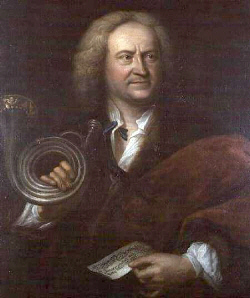

Bach composed his famous Hunt Cantata BWV 208 for the birthday of Duke Christian of Saxe-Weißenfels around 1713, when he was paid for a series of concerts in Weißenfels.
Gottfried Reiche, 1667-1734, is best known for having been Johann Sebastian Bach’s chief trumpeter at Leipzig from Bach’s arrival there in 1723 until Reiche’s death. Reiche was a skilled trumpet player and composer of the Baroque era, and Bach wrote amazing and difficult trumpet parts for him to play. He was so highly esteemed that in Leipzig he was paid more than other musicians so that he would not leave and seek employment elsewhere. In the famous painting of him by Leipzig artist E.G. Haussmann, done for the occasion of Reiche’s 60th birthday in 1727, Reiche holds a coiled natural trumpet in his right hand and a sheet of manuscript, on which is written a short “abblasen,” his famous fanfare, in his left.
Reiche composed 122 Abblasen-Stücken, but few survived other than this one, although some scholars attribute it to Bach himself. Reiche died of a stroke, collapsing in the street while walking home one night. There are many legends about both he and the portrait.